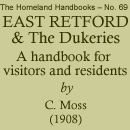< Previous | Contents | Next >
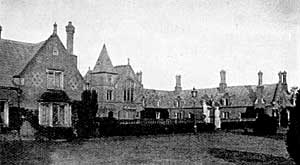
Trinity Hospital, West Retford.
Near to the church is Trinity Hospital. [For permission to view, apply on the premises or to the bailiff— Mr. E. Wilmshurst, West Retford,]. The Hospital of the Holy and Undivided Trinity was founded by John Darrel, B.A., M.D., who devised his mansion and ancestral estate, comprising most of the parish of West Retford, for the support of sixteen decayed brethren, who should form a corporation with a common seal, with the sub-dean of Lincoln as master-governor. The present value of the charity with perquisites is £50 per annum to each brother. A nurse is provided. There is also a bailiff to manage the hospital and estates. John Darrel also founded by will, November, 1664, an exhibition for some "ingenious scholar" . . . to be chosen in turn from Lincolnshire and Nottinghamshire, to be educated at Exeter College, Oxford. The present value of the scholarship is £7o per annum.
(d) to Spa Common and South Retford.
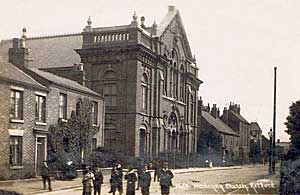
Wesleyan Chapel on Grove Street, c. 1910.
From the Market-place we pass along Grove Street (formerly Newgate). The Wesleyan Chapel, Grove Street, is a handsome structure, built 1879-1880, to accommodate 1,000 persons. At the end of Grove Street we have, on the left, the residential neighbourhood of Alma Road and on the right, Spa Common— two or three acres in extent, the only common now in the possession of the burgesses out of fifty acres which existed half a century ago. The spa or well, which was supposed to be a specific for scurvy, etc., was open to the public for probably three hundred years, but was closed in 1815.
In 1837 it was re-opened by private enterprise, and pumping apparatus was erected, in the hope of its proving a benefit to humanity, and a profit to the town. The sanguine expectations were not realised, and all traces of the spa are now lost.
Crossing the Canal Bridge we come to a modern district, all built within the last thirty years. Continuing along Pennington's Walk to Dominie Cross Road, we find ourselves presently on the Great North Road, in the district known as South Retford (though in the parish of Ordsall). For nearly a mile south-wards, as far as and including the hamlet of White Houses, the highway is lined with the residences of leading inhabitants. This southern approach (as well as the northern) is decorated with trees.
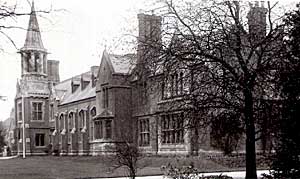
The Grammar School, c.1910.
In Holly Road, at the foot of Millington's Hill, is the church of St. Alban (open all day), an auxiliary to the parish church of All Hallows, Ordsall, designed by C. Hodgson Fowler, and opened in 1903. At present it is incomplete. At an outlay of about £4,000 the chancel with its most beautiful chancel-arch, and a portion of the south aisle, have been erected. The finished section (boarded off) is now in use. The east window, by Kempe, erected to the memory of Mr. Samuel Jones, late Town Clerk of East Retford, is a perfect work of art, said to be one of the artist's finest efforts. On the declivity of the hill is the Girls' High School with its environment of ornamental grounds, and adjacent to St. Alban's Church, is King Edward VI. Grammar School. This building is handsome and commodious. Standing back from the roadway, surrounded by lawns, pleasure grounds, and playing fields, its front adorned with trees, with its pointed gables, and Gothic style of architecture, it is the ornament of the district. In bygone days, its endowments were grossly misappropriated, and are now confined for the most part to an estate at Bleasby, on the river Trent, near Newark. Its predecessor (erected 1779) stood on the north side of Chapelgate, on the site of the present vicarage grounds. The present school was erected in 1854 at a cost of about £9,000. Since then, however, valuable additions have been made in workshops, gymnasium, lecture rooms, laboratories, etc., so that the school is one of the best of its kind, well up to date, and abreast of modern educational requirements. A year ago another building was added as a centre for the training of girls as teachers for elementary schools, and in 1905 the Duke of Portland presented a handsome painting of King Edward VI., the founder of the school. This is a replica of the picture at Welbeck, of the school of Holbein. It represents the young king in jewelled crimson dress, wearing the Garter on the left leg, and is framed in black and gold.
(e) to Ordsall Village.
Resuming our perambulations we start again from the Market-place, this time along Carolgate. In Exchange Street, to the right, are the Corn Exchange, Butter Market, Temperance Hall, and Police Station. The Primitive Methodist Chapel (Carolgate) occupies the site of a theatre, famous in its day, the only one the town ever possessed. Opposite, in a side street, Spa Lane, the first Wesleyan Chapel, now used as a warehouse, was built in 1779. West Street contains the barracks of the 4th Notts. Volunteers (Retford Compy.) A movement is on foot to build a new Drill Hall. On the Corporation Wharf, at the "west side of the weighing machine," stood the "stock-house or gaol" built 1779. Here the stocks, granted by Edward I, (1279) were used in 1835 for the last time, when "Neddy Golland" was placed there for being drunk. Another stocks was at the end of the Town Hall, which stood in the Marketplace parallel with the White Hart and the shops adjoining.
Passing over Carolgate Bridge, by the Congregational Church, to the right down Thrumpton Lane, by the manufactory of the Northern Rubber Company, and over the railway crossing, by the engineering works of Mr. W. J. Jenkins, J. P., and the Council Schools in the hamlet of Thrumpton, we arrive at the village of Ordsall on the west bank of the Idle, still in the confines of the borough.
Ordsall village is about a mile to the south-west of Retford, half a mile from the line of the Great North Road, and a quarter of a mile from the railway-station. The population of the parish increased from 955 in 1841, to 5,199 in 1901. It was included in the borough by the Act of 1878. It is mentioned in the reign of Edward the Confessor, also in Domesday Book. After the Conquest it passed, of course, into the hands of Roger de Busli, and was subsequently owned by the Hercys of Grove.
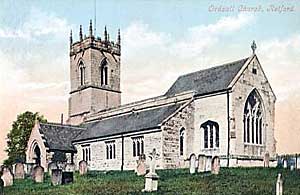
Ordsall church, c.1905.
Across the river, near the bridge, is an old mill formerly used for the manufacture of paper. The view here, with the stream rushing down the old mill race, is extremely pretty. Ordsall is a long, straggling village, which includes several good houses; it is well worth a visit, if only for the sake of Ordsall Parish Church. [Open all day]. This church, dedicated to All Hallows, is of much interest, and is excellently preserved and kept, both inside and out. It is believed to have been founded in Norman times, but Piercy dates it from "about the middle of the thirteenth century." It bears marks of the Early English and Decorated periods. It consists of a lofty pinnacled tower containing six bells, north and south aisles, and chancel. It was enlarged and thoroughly restored in 1887. Each of the aisles is divided from the nave by four moulded arches, springing from octagonal pillars: two of the three capitals are beaded as in the Norman style.
The vestry north of the chancel contains a recent window, descriptive of the Crucifixion; and the large eastern window in the chancel itself, portrays the Resurrection. Both these are modern Decorated windows. The north window of the chancel (Kempe) is of great merit. It was erected 1905. There are two windows to the Brough family. The carved oaken choir stalls and the pulpit were added at the 1877 restoration. The clergy stalls and the brass reading desk are modern, but there is a fine screen of ancient date here, of carved oak, heavily canopied, which was brought from Hayton Castle, and divides the ringing-chamber from the body of the church.
In the tower is a tablet to the memory of Jer. Halfhide (1727); a table of benefactions; and a fine old marble monument of the kneeling figure of a man in sumptuous habiliments, including the Elizabethan ruff, kneeling before an open-book on the Litany-desk, of which the history is unknown. There are also marble tablets on the wall of the south aisle.
The Communion plate includes a chalice, 1517; patens of ancient date; and a silver flagon of great beauty, the gift of Mrs. Anne Turnell, widow, the only daughter and heir of Sir Richard Brownlow, of Thrumpton, "for the use of the communicants of the Parish of Ordsall for ever, 1724." Above this inscription is the Brownlow coat of arms. The registers, which are excellently preserved, commence in the year 1538.
The religious persecutions of various times reached Ordsall. In 1535 proceedings were taken in the Star Chamber against "Sir Robert Nevyll, clark, parson of Ordesall, and Sir Edmund Webster, chaplen and parysshe pryste" for refusing the sacrament unless Peter's pence were paid to the Pope. The charge was denied, and there is, apparently, no record of any conviction. The Rev. Wm. Denman was extruded from his benefice towards the end of Queen Mary's reign, but was reinstated in Queen Elizabeth's. The Rev. Marmaduke Moor, in 1652, during the Commonwealth, had his estate forfeited for treason, and was sequestrated from his benefice "for the heinous and damnable offence of playing at cards three several times with his own wife." (The return to the town is by way of the railway, station—one mile.)
